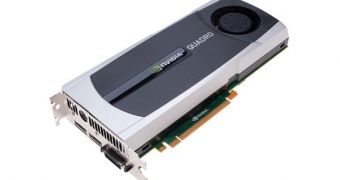In terms of consumer graphics cards, NVIDIA is still a way off from covering the entire market with DirectX 11-capable models. The same cannot be said about the professional front, however, now that the Santa Clara, California-based company has unleashed its line of Fermi-based series of Quadro adapters, all enabled by the GF100 graphics processing unit. This new collection promises higher performance and a wider feature set compared to its predecessor.
So far, NVIDIA has unleashed five products. The Quadro 4000 has 2GB of GDDR5 memory and 256 stream processors (SP). Also, the Quadro 5000 has 2.5GB VRAM and 352 stream processors, whereas the Quadro 5000M, for mobile workstations, boasts 2GB GDDR5 and 320 SP.
Furthermore, the Quadro 6000 has a good 6GB VRAM and 448 stream processors. As for the Quadro Plex, it is the most powerful by far, with a massive 12GB of memory and 896 SP.
"We have built engines like AXE to enable the creation of next-gen applications. When you couple these technologies with our Fermi architecture, the result is a new Quadro family that's exponentially better than anything the market has ever seen " said Jeff Brown, general manager, professional solutions group at Nvidia.
The newcomers support, besides DirectX 11, OpenCL 1, OpenGL 4 and 3D Vision Pro. They are also the first to bring the benefits of ECC (error correction code) combined with IEEE double precision floating point performance. NVIDIA also pointed out that the Fermi architecture greatly enhances geometry processing capabilities, which translates into a fivefold boost to 3D rendering and up to eight times faster performance during simulations.
Finally, the GPU maker also revealed so-called acceleration engines (AXEs), SceniX 6, Nvidia Cg Tooklit 3 and OptiX 2 to be exact. They will assist software developers in the making of next-generation professional applications that perform such things as ray tracing, physics simulation, real-time video effects processing and computational fluid dynamics.

 14 DAY TRIAL //
14 DAY TRIAL //